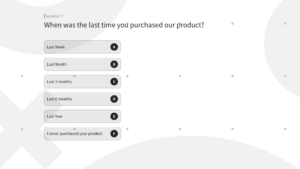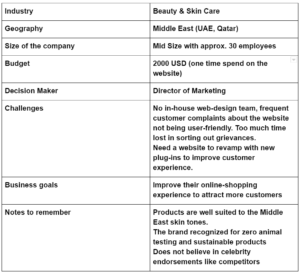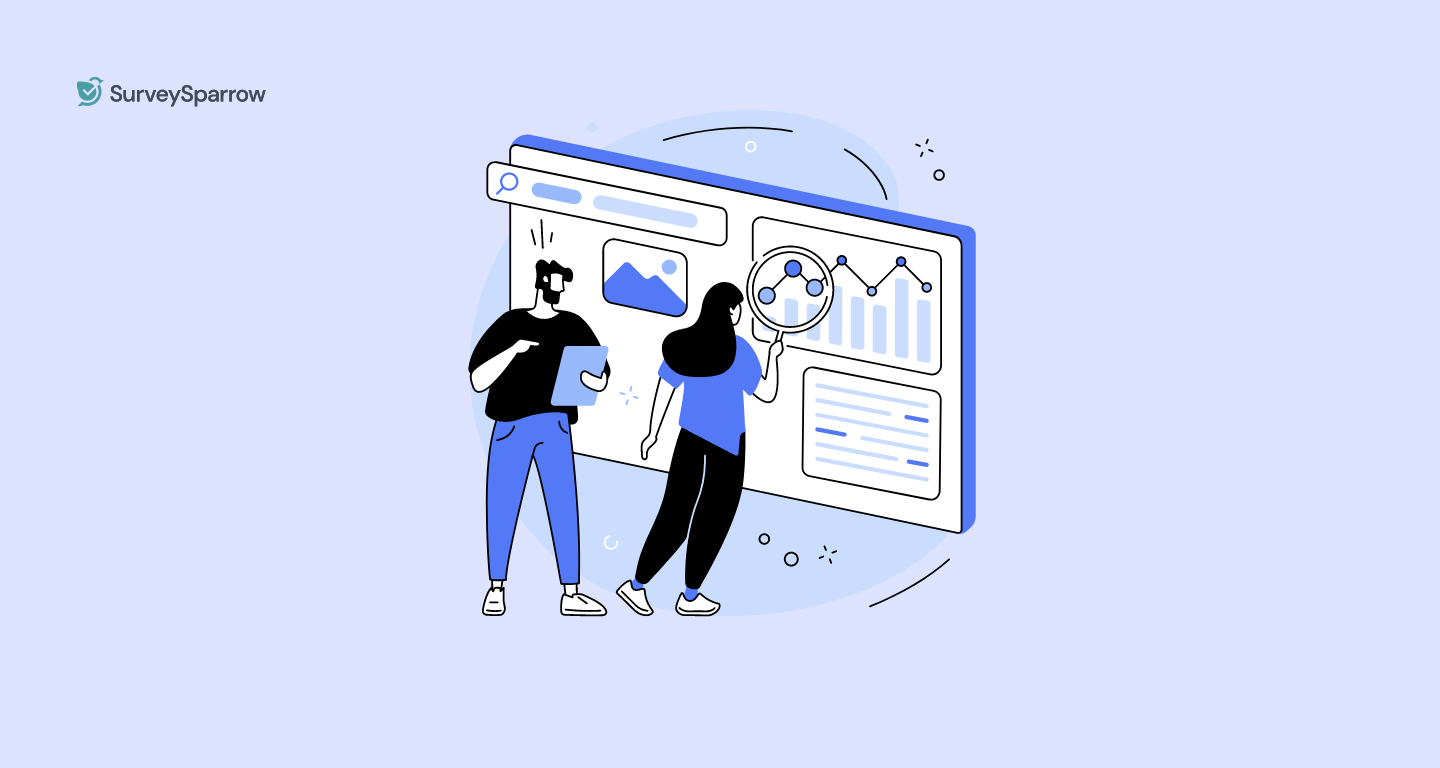Others
How to create an Ideal Customer Profile - A Complete Guide
Article written by Kate Williams
Product Marketing Manager at SurveySparrow
11 min read
19 September 2025

Take a closer look at the success stories of the world’s most trusted brands, and you will find one key characteristic common to all – relentless commitment towards their customers. You will notice that every business decision is centered on its customer. Be it a product, pricing, sales, or marketing.
If you are a business leader or an entrepreneur reading this, ask yourself the most important question – How well do you and your teams really understand your customer? No matter how creative your marketing campaign turns out or how hardworking your sales team is, none of that will bear any fruit if you do not know your customer’s desires and pain points.
And this is where an Ideal Customer Profile, ICP, proves extremely useful.
New to the term? No worries, let’s start from the basics.
What is an Ideal Customer Profile (ICP)?
According to Inbound marketing leader Hubspot, “An ideal customer profile (ICP), commonly referred to as an ideal buyer profile, defines the perfect customer for what your organization solves for. This fictitious company has all of the qualities that would make them the best fit for the solutions you provide.”
To put it simply, an ideal customer is the perfect customer for whom your product or service fulfills a specific need. This profile of customers stands to gain enormously from your business offering and provides substantial value in return. Value not just in terms of money but also in the form of testimonials, referrals, insights about the product, and so on. They become the spokesperson for your brand.
The ICP is an actual representation of the audience that you must focus on while making your key business decisions, whether it is related to product features, sales, or marketing. Creating customer profiles ensures that you spend your money, time, and efforts on attracting and converting the right leads.
Difference Between Buyer Personas and Ideal Customer Profile
Ideal Customer Profiles (ICPs) are high-level descriptions of the organizations or individuals that would benefit most from your product or service. They focus on key characteristics like industry, size, and the core pain points your solution addresses. ICPs align marketing and sales efforts towards the most fitting targets, streamlining lead qualification and account-based marketing strategies.
On the other hand, Buyer Personas are detailed semi-fictional representations of the individuals who will buy your product or service. Hubspot defines buyer personas as “semi-fictional, generalized representation of your customers that account for the demographics, goals, motivators, and fears.”
Unlike ICPs, Buyer Personas delve into the personal level, aiding in crafting personalized marketing and sales messaging. They are typically used in content creation, email marketing, and other targeted marketing strategies to engage individuals in a more personalized manner.

Why is an ICP Important for Your Marketing Strategy?
An Ideal Customer Profile (ICP) is a cornerstone in crafting a robust marketing strategy, acting as a compass in navigating the complex marketplace. Here are key points illustrating the importance of an ICP for your marketing strategy:
- Targeted Marketing: Enables focused and effective campaigns.
- Resource Optimization: Ensures efficient allocation of marketing resources.
- Improved Lead Quality: Generates higher-quality leads more likely to convert.
- Sales and Marketing Alignment: Provides a clear target for both teams.
- Better Product Development: Offers insights for product improvements.
- Increased Customer Satisfaction and Retention: Attracts right-fit customers.
- Data-Driven Decision Making: Promotes informed decisions based on data.
- Performance Measurement: Allows for better evaluation of marketing effectiveness.
Now, to the most important part –
How do You Create an Ideal Customer Profile?
Just having a broad idea of who your target audience is is never really enough. Guesswork will not get you the correct results. Understanding your customer in detail is the key to steady growth.
Here’s an ideal customer profile template from SurveySparrow that you can use for free.
Get this ideal customer profile template for free now:
14-day free trial • Cancel Anytime • No Credit Card Required • No Strings Attached
4 Steps to Craft an Ideal Customer Profile
1. Define what your corporate stands for
Creating an ICP in marketing or any other field begins with outlining what your business stands for. You must be clear about your enterprise’s vision, mission, and goals. This also includes defining the unique value that you are providing to the customer. It is an ongoing process. As customer’s needs and wants change, your business must be able to adapt and transform.
Also, your brand positioning determines the kind of patrons you want to attract and retain over time. Once you are clear about your brand identity, it helps you decide who your customers should be.
2. Gather information from your best customers
Consistent and constructive feedback is one of the best ways to improve any product or service. And no one better than your existing customers can provide these details.
Reach out to your top ten customers who love your product and are loyal to your brand. Keep in mind that they should be the ones getting the maximum value from your product or service. Choosing the best ten is essential; they will likely give you their time and help you in your endeavor.
A good way to narrow down your top ten is by asking the right questions:
Have they been with you for a long time?
Have their business objectives been met by using your brand?
Has it helped them increase their ROI?
If you are a new entrant into the market or a start-up entrant, list potential customers who would benefit the most from your product and keep coming back for more.
Once you have your top ten ready, divide them into various categories based on the information that you already have, such as:
Industry
Geography
Size of the company
Budget
Then, schedule a meeting with them to gather more details. Getting to know them better is the best way to profile them. Remember that the more specifics you can gather about your ideal customer, the higher your chances of creating a winning marketing and sales strategy. A face-to-face meeting is perfect when it comes to strengthening existing customer relationships.
However, if they are unavailable for a direct meeting, the following effective method of collecting information is video conferencing or a telephonic interview. The data can be collected using a survey if circumstances do not favor a video call or consultation.
Remember that a survey may not be the most convenient for them. So you will need to weave in some attractive features like a discount code or a beautiful gift upon completing the survey.
This exercise aims to understand their buying/decision-making process, their experience with your product (both positive and negative), their business goals, and so on.
To aid you further, we have listed below some key questions that cover these aspects –
- Which inquiries are made before a purchase?
- What motivated the decision to opt for your product?
- Which aspects are favored the most?
- Are there any challenges or discomforts encountered?
- Why do they continue to use your product?
- What are their business goals for the upcoming year?
- Who are their top customers?
- What technology do they have?
This is not an exhaustive list. Depending on your business’s nature and the details you need, you may need to add or remove questions. The rapport you share with your top customers will also play a role in gathering honest and timely feedback.

3. Identify the important categories
Once you have received all the information and entered it into your CRM, you need to identify common attributes amongst these top ten customers. It could be similar patterns in decision-making, common challenges, etc.
4. Document the results in a template
The last step is to record all the information across the different categories in an ICP framework. Several companies use different types of ICP templates or worksheets for this.
Let’s illustrate this further using an example –
Imagine you are a B2B company that specializes in creating and troubleshooting websites. Your target audience includes small and medium-sized firms selling consumer goods in the Middle Eastern region.
A sample ideal customer profile template could look like this –

How to Ensure Your ICPs are Up-to-date?
Now that you have done your customer profile analysis, it does not mean the work is over. What is more important is that these profiles are consistently updated and improved to ensure the smooth running of operations. The accuracy of your buyer personas also depends on your ICPs.
Here are a few ways to ensure that your ICPs are up-to-date: –
1. Stay connected to your customer
Always review their feedback and systematically address their pain points. You never know. You might chance upon a new group of customers or even get some insights into their buying process to help you craft your next marketing message.
2. Pay attention to the website and social
By examining the number of visitors to your website and the time that they spend on your blog posts, videos, and all other types of content is a good way to profile them more accurately. Social media statistics also reveal much about your consumer’s interests and habits. You can get the help of Google Analytics to analyze their digital preferences.
3. Look back at your own success stories
Revisit the most successful deals you have won in the past and compare that process with the current ones. Try to notice any change in trends in buying behavior and see what happened just before the customer decided to sign the dotted line. A comparative study can reveal some interesting results that will give you a better idea of your customer.
But why take all this trouble? The benefits are plenty!
Top 4 Benefits of Creating an Ideal Customer Profile
Here is why every business today must have an ICP: –
1. Improved alignment between functions
With an ICP, your product, sales, and marketing teams understand the customer better. This helps them to stay focused on a unified goal and work in alignment to achieve the desired results.
The product team is armed with information on how to enhance the product’s various features and make it more attractive to the ideal customer.
Buyer personas can be created within the ICPs. These personas help the marketing team with social media messaging and running effective campaigns.
ICPs guide the sales team on which lead to prioritize and pursue. They can focus on leads that matter, thereby improving conversion rate. To sum up, an ICP allows you to generate high value for your business quickly.
2. Gain more referrals
As ideal customers already love your product and services, they are naturally happy to recommend it to other potential customers. They are satisfied with your product as it solves a problem.
If your product has changed how it operates and made a remarkable difference to its revenue, these customers automatically become your brand advocates.
They will likely refer you to similar companies facing the same challenges. Thus, it becomes easier to gain more referrals and new leads.
3. Improve customer retention
A study by Bain and Company shows that a 5% increase in customer retention can increase profitability by 75%.
The more information you have on your current customer, the easier it becomes to address grievances, smoothen the onboarding process, and improve service delivery. When your customer knows you care about them deeply, their faith in you strengthens. They would rather stay with you than switch over to a competitor.
4. Boost Business
With accurate ICPs, every resource in your organization is used more effectively. This leads to lower wastage, reduced expenses, and increased ROI. Updated ICPs also help the company transform and adapt to customer trends and preferences. The organization experiences steady growth and continues to stay agile and customer-focused.
Conclusion
No matter how big or small your business is, maintaining a strong relationship with your customers is the only way you can grow.
We hope the steps above help you define your ideal customer who will accelerate your business growth and help build strong brand value.
“Get closer than ever to your customers. So close, in fact, that you tell them what they need well before they realize it themselves.” – Steve Jobs

Thousands of brands trust SurveySparrow to turn feedback into growth. Try it free today!
Kate Williams
Excels in empowering visionary companies through storytelling and strategic go-to-market planning. With extensive experience in product marketing and customer experience management, she is an accomplished author, podcast host, and mentor, sharing her expertise across diverse platforms and audiences.
Related Articles

Others
Top 9 Customer Analytics Tools and Platforms
15 MINUTES
11 May 2024

Others
Types of Dashboards: Strategic, Operational, Analytical
12 MINUTES
10 December 2023

Others
13 Best Tools for Small Businesses
27 MINUTES
24 July 2022

Others
DNS Cache Flushing: Improve Website Speed and Performance
5 MINUTES
23 August 2024
